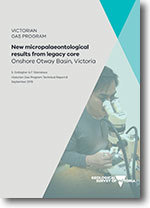VGP Technical Report 8 - New micropalaeontological results from legacy core
 |
| |||||||||||||||
Product description:About the Victorian Gas Program: The Victorian Gas Program (VGP) is a comprehensive science-led program, incorporating geoscientific and environmental research to assess the risks, benefits and impacts of potential onshore conventional gas exploration and production. The program is also investigating the potential for further discoveries of onshore conventional and offshore gas in the Otway and Gippsland geological basins and assessing the feasibility of additional onshore underground gas storage in depleted reservoirs around the Port Campbell area. The VGP includes an extensive, proactive and phased community and stakeholder engagement program, through which the results of the scientific studies are being communicated. Executive summary: A major review of the biostratigraphy of the onshore Otway Basin was undertaken as part of the Victorian Gas Program (VGP). Biostratigraphy is the study of fossils to date rock formations. The biostratigraphy study was conducted in two parts: (1) a palynology study and (2) a study of micropalaeontology. This report details the findings of the micropalaeontology component of the study. New micropalaeontology results have been obtained from selected legacy core samples from subsurface rock formations in the Victorian onshore Otway Basin. The results of these analyses fill data gaps in the Geological Survey of Victoria (GSV) historical micropalaeontological dataset. This study was only possible due to the large number of legacy core samples available at the Geological Survey of Victoria Drill Core Library, Werribee and represents one of the most comprehensive, basin-scale biostratigraphic projects to be undertaken in Australia. As part of the VGP geoscience program, GSV is studying petroleum systems components (reservoir, seal and source), to assess the petroleum prospectivity of the Victorian Otway Basin and estimate the potential for further conventional gas discoveries, onshore and offshore within Victoria’s jurisdiction. The analyses presented in this report contribute to GSV’s regional geological knowledge, allowing more confident assessments of the hydrocarbon prospectivity of the Otway Basin by dating rock formations and understanding the environments the rocks were deposited in. Over geological time, living organisms such as plants and animals have evolved, diversified and adapted, and some have become extinct. When these organisms die, some of their remains are fossilised. Fossils can be extracted from rocks by palaeontologists. The age of the rock and the environment the organisms lived in can be determined. From this data a robust biostratigraphic framework (where fossils are used to date rock formations) helps to correlate between underground rock layers and understand ancient depositional environments. GSV engaged MG Palaeo Pty Ltd in Malaga, Western Australia to conduct a review of legacy datasets, compile a list of potential rock samples and undertake new palynological and micropaleontological analysis to infill data gaps. Legacy data from 249 onshore Otway Basin wells and boreholes were reviewed, resulting in the selection of 1060 rock samples for new biostratigraphic analyses from 120 onshore Otway Basin wells and boreholes. The biostratigraphy study utilised both palynological (fossilised spores, pollen and organic-walled microplankton) and micropalaeontological (fossilised foraminifera) data as these complimentary approaches provide higher resolution correlations when combined. The two techniques often also work better in differing rock types (mud/siltstones versus carbonates), thus allowing a more complete understanding of the stratigraphy. The final program included new analyses of 748 palynology samples (115 wells and boreholes) and 312 micropalaeontological samples (24 wells and boreholes). For the micropalaeontology study, samples taken from the GSV Drill Core Library were processed at The University of Melbourne. Preparation included chemical disaggregation of a weighed sample using wet sieving. The residue was dried and split using a microsplitter to a known fraction of sample. To achieve quantitative analyses all the microfossils in this fraction were spread out on a picking tray and identified using a binocular microscope and counted. This allowed quantitative estimates of the yield of foraminifera per gram and the percentage and diversity of the assemblages to be calculated from each sample. The final datasets for the two studies include all the available palynological and micropalaeontological data (both the new data and the fully reviewed legacy data) for the onshore Otway Basin. The final micropalaeontology datasets are included in the accompanying appendices and attachments in this report. GSV are using the new micropalaeontology analyses presented in this report to refine formation tops in the Otway Basin as part of the VGP prospectivity assessment. Bibliographic reference: Gallagher, S., & Stanislaus, F.,2019. New micropalaeontological results from legacy core Onshore Otway Basin, Victoria. Victorian Gas Program Technical Report 8. Department of Jobs, Precincts and Regions. Download: The downloadable version of this report is supplied in PDF format (3.6 MB), accessible version (DOCX 11.0 MB) and Attachments A1-A5 (ZIP 22.6 MB). Related products:
| ||||||||||||||||


